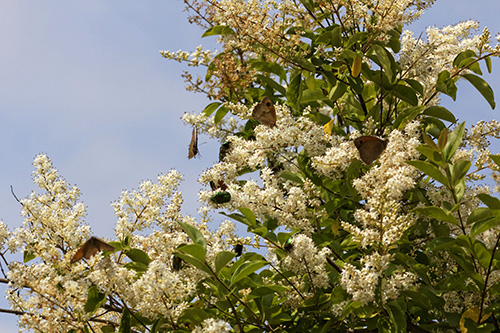Ligustrum
Ligustrum sp.
Japanese Privet (Ligustrum japonicum) - Although often used as a shrub or hedge, Japanese Privet works well when allowed to grow into a small tree, its curved multiple trunks and dark green canopy creating an interesting architectural focus, 8 to 12 feet tall and often considerably wider, for the landscape. Old specimens can grow to 25 feet across. The glossy evergreen leaves are abundantly produced on the upright, spreading branches. The small, white, malodorous flowers appear in terminal panicles during spring in the south and in the summer in northern climes. The blooms are followed by abundant blue-black berries which persist most of the year. The berries are popular with birds and the dispersed seeds occasionally germinate where they fall but this is usually not a nuisance.
Glossy Privet (Ligustrum lucidum) - This fast-growing evergreen tree, 25 to 40 feet in height (can grow larger) with a 25 to 35 foot spread, has a dense canopy of bending branches composed of large, four to six-inch-long, glossy green leaves which have narrow, translucent margins. Terminal, 6 to 10-inch-long, eye-catching panicles of small, white, malodorous flowers are produced in late spring in the south and summer in the north. These blooms are followed in fall by large, showy clusters of small purple berries. The berries are popular with birds and the dispersed seeds germinate in the landscape and could become somewhat of a nuisance. Care must be taken in the location of this multitrunked tree since the profuse berry production can create a litter problem on hard surfaces. The fallen berries may stain car paint, walks, and patios.
Visit our Tree Campus homepage for more information.
Japanese Privet information provided with permission of the Environmental Horticulture Department, UF/IFAS Extension, Publication #ENH-511, one of a series. Original publication date November 1993. Revised March 2007. Reviewed February 2014. For more information visit the EDIS website at http://edis.ifas.ufl.edu.
Glossy Privet information provided with permission of the Environmental Horticulture Department, UF/IFAS Extension, Publication #ENH-513, one of a series. Original publication date November 1993. Revised April 2007 and February 2013. For more information visit the EDIS website at http://edis.ifas.ufl.edu.


